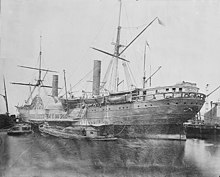
The War Shipping Administration (WSA) was a World War II emergency war agency of the US government, tasked to purchase and operate the civilian shipping tonnage the United States needed for fighting the war. Both shipbuilding under the Maritime Commission and ship allocation under the WSA to Army, Navy or civilian needs were closely coordinated though Vice Admiral Emory S. Land who continued as head of the Maritime Commission while also heading the WSA.

Fort Mason, in San Francisco, California originated as a coastal defense site during the American Civil War. The nucleus of the property was owned by John C. Frémont and disputes over compensation by the United States continued into 1968. In 1882 the defenses were named for Richard Barnes Mason, a military governor before statehood. Fort Mason became the headquarters for an Army command that included California and the Hawaiian Islands from 1904 to 1907. In 1912 the Army began building a port facility with piers and warehouses to be a home base for ships of the Army Transport Service serving Alaska, Hawaii, the Philippines and other Pacific Army posts and focus of Army supply for the Pacific.

The San Francisco Port of Embarkation (SFPOE) was a United States Army command responsible for movement of supplies and troops to and from the Pacific during World War II with extensive facilities in the San Francisco area. SFPOE was established 6 May 1932 and disestablished 1 October 1955. It was originally composed of the long term Pacific terminal at Fort Mason that had been the home port and terminal for the Pacific Army Transport Service ships. That facility was far too limited to serve the requirements of a full port of embarkation. In 1940 the port began expansion to include Army owned and leased facilities throughout the San Francisco Bay area and for a time sub ports at Seattle and Los Angeles. Those eventually became separate commands as the Seattle Port of Embarkation and Los Angeles Port of Embarkation.

The Boston Port of Embarkation (BPOE) was a United States Army command responsible for the movement of troops and supplies from the United States to overseas commands. In World War I it was a sub-port of the New York Port of Embarkation. During World War II it became an independent Port of Embarkation with the second greatest number of passengers embarked and third greatest tonnage of cargo embarked by east coast Ports of Embarkation. In passengers it was exceeded on the east coast only by New York and in cargo only by New York and the Hampton Roads Port of Embarkation. Within three months after entry of the United States into World War II Boston was being established as a sub-port of New York. With establishment of the United States Army Transportation Corps in March 1942 the Boston sub-port became the independent Boston Port of Embarkation.

The New York Port of Embarkation (NYPOE) was a United States Army command responsible for the movement of troops and supplies from the United States to overseas commands. The command had facilities in New York and New Jersey, roughly covering the extent of today's Port of New York and New Jersey, as well as ports in other cities as sub-ports under its direct command. During World War I, when it was originally known as the Hoboken Port of Embarkation with headquarters in seized Hamburg America Line facilities in Hoboken, New Jersey, the Quartermaster Corps had responsibility. The sub-ports were at Boston, Baltimore, Philadelphia and the Canadian ports of Halifax, Montreal and St. Johns. The World War I port of embarkation was disestablished, seized and requisitioned facilities returned or sold and operations consolidated at the new army terminal in Brooklyn. Between the wars reduced operations continued the core concepts of a port of embarkation and as the home port of Atlantic army ships. With war in Europe the army revived the formal New York Port of Embarkation command with the New York port, the only Atlantic port of embarkation, taking a lead in developing concepts for operations.
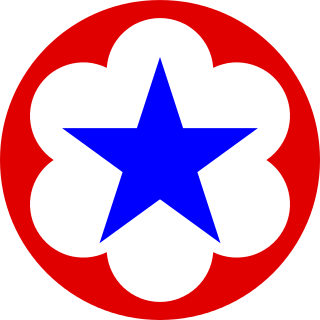
The Army Service Forces was one of the three autonomous components of the United States Army during World War II, the others being the Army Air Forces and Army Ground Forces, created on 9 March 1942. By dividing the Army into three large commands, the Chief of Staff, General George C. Marshall, drastically reduced the number of officers and agencies reporting directly to him. The Army Service Forces brought together elements of five different components of the Army: elements of the War Department General Staff (WDGS), especially its G-4 division ; the Office of the Under Secretary of War; the eight administrative bureaus; the nine corps areas, which became service commands; and the six supply arms and services, which became known as the technical services. The Army Service Forces was initially known as the United States Army Services of Supply but the name was changed on 12 March 1943, as it was felt that the term "supply" did not accurately describe the broad range of its activities. The Army Service Forces was abolished on 11 June 1946 and most of its functions were taken over by the War Department General Staff.
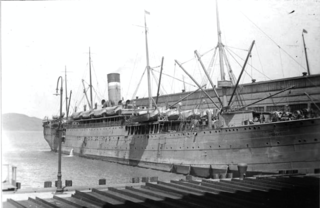
USAT Thomas was a United States Army transport ship purchased on 26 July 1898 for Spanish–American War service. Thomas served with the Army Transport Service (ATS) until retired in 1929.

SS Munargo was a commercial cargo and passenger ship built for the Munson Steamship Line by New York Shipbuilding Corp., Camden, New Jersey launched 17 September 1921. Munargo operated for the line in the New York-Bahamas-Cuba-Miami service passenger cargo trade. In June 1930 the United States and Mexican soccer teams took passage aboard Munargo from New York to Uruguay for the 1930 FIFA World Cup. The ship was acquired by the War Shipping Administration and immediately purchased by the War Department for service as a troop carrier during World War II. Shortly after acquisition the War Department transferred the ship to the U.S. Navy which commissioned the ship USS Munargo (AP-20). She operated in the Atlantic Ocean for the Navy until returned to the War Department in 1943 for conversion into the Hospital ship USAHS Thistle.

Great Northern was a passenger ship built at Philadelphia by William Cramp & Sons under supervision of the Great Northern Pacific Steam Ship Company for the Spokane, Portland and Seattle Railway Company, itself a joint venture of the Great Northern Railway and Northern Pacific Railway. Great Northern, along with sister ship Northern Pacific, were built to provide a passenger and freight link by sea between the northern transcontinental rail lines via the Spokane, Portland and Seattle Railway terminal at Astoria, Oregon and San Francisco beginning in spring of 1915.
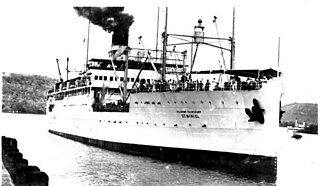
St. Mihiel was a troopship built for the United States Shipping Board by the American International Shipbuilding Corporation at Hog Island, Pennsylvania. The ship was operated from 1922 until mid-1940 as USAT St. Mihiel by the Army Transport Service. In July 1941 the ship was transferred to the Navy which commissioned her USS St. Mihiel with the hull number AP-32. In November 1943, she was transferred back to the Army and converted into the hospital ship, USAHS St. Mihiel.
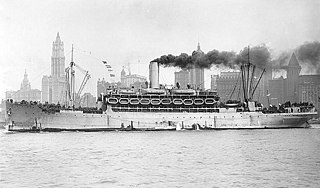
John L. Clem was built as the cargo and passenger liner Santa Ana for W. R. Grace and Company for service in Grace Line's South American service but was requisitioned before completion by the United States Shipping Board (USSB) in 1918 due to World War I. The ship was chartered back to Grace after completion until turned over to the United States Navy to be briefly commissioned as the troop transport USS Santa Ana (ID-2869) from 11 February 1919 to 21 July 1919.

USAT Thomas H. Barry, formerly SS Oriente, was a Ward Line ocean liner that became a United States Army troopship in the Second World War. She was intended for transfer to the United States Navy and assigned the hull number AP-45, but was not transferred and remained with the Army.
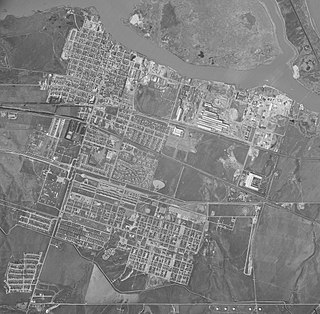
Camp Stoneman was a United States Army facility located in Pittsburg, California. It served as a major troop staging area for and under the command of the San Francisco Port of Embarkation (SFPOE). The camp operated during World War II and the Korean War.

USAHS Acadia was the first United States Army Hospital Ship in World War II. Built in 1932 by Newport News Shipbuilding as a civilian passenger/cargo ocean liner for the Eastern Steamship Lines, the ship was in US coastal and Caribbean service prior to its acquisition by the US Maritime Administration in 1941.

Hampton Roads Port of Embarkation was the Army command structure and distributed port infrastructure in the Hampton Roads area of Virginia supporting movement of personnel and cargo overseas. It had been activated as the Newport News Port of Embarkation in World War I, deactivated, then reactivated 15 June 1942.

SS Sea Owl was a Type C3-S-A2 ship built during World War II by Ingalls Shipbuilding, Pascagoula, Mississippi. The ship was converted by Ingalls before delivery on 27 June 1944 into a troop transport for operation by the War Shipping Administration. The ship saw service in the European Theater of Operations with a final trip in January 1946 to Japan and return. The ship was released from troop service in February 1946 and placed in the James River Reserve Fleet 12 August 1946.

SS Claymont Victory was a type Victory ship-based VC2-S-AP2 troop transport built for the U.S. Army Transportation Corps late in World War II. Launched in November 1944, it saw service in the European Theater of Operations during 1945 and in the immediate post-war period repatriating U.S. troops.

SS Rushville Victory was a Victory ship-based troop transport built for the US Army Transportation Corps (USAT) late in World War II under the Emergency Shipbuilding program. It saw service in the European Theater of Operations in 1945, 1946 and in the immediate post-war period repatriating US troops.

